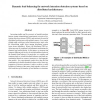Free Online Productivity Tools
i2Speak
i2Symbol
i2OCR
iTex2Img
iWeb2Print
iWeb2Shot
i2Type
iPdf2Split
iPdf2Merge
i2Bopomofo
i2Arabic
i2Style
i2Image
i2PDF
iLatex2Rtf
Sci2ools
NCA
2007
IEEE
2007
IEEE
Dynamic load balancing for network intrusion detection systems based on distributed architectures
Increasing traffic and the necessity of stateful analyses impose strong computational requirements on network intrusion detection systems (NIDS), and motivate the need of distributed architectures with multiple sensors. In a context of high traffic with heavy tailed characteristics, static rules for dispatching traffic slices among distributed sensors cause severe imbalance. Hence, the distributed NIDS architecture must be combined with adequate mechanisms for dynamic load redistribution. In this paper, we propose and compare different policies for the activation/deactivation of the dynamic load balancer. In particular, we consider and compare single vs. double threshold schemes, and load representations based on resource measures vs. load aggregation models. Our experimental results show that the best combination of a double threshold scheme with a linear aggregation of resource measures is able to achieve a really satisfactory balance of the sensor loads together with a sensible ...
| Added | 04 Jun 2010 |
| Updated | 04 Jun 2010 |
| Type | Conference |
| Year | 2007 |
| Where | NCA |
| Authors | Mauro Andreolini, Sara Casolari, Michele Colajanni, Mirco Marchetti |
Comments (0)

